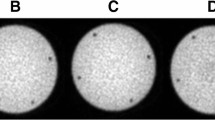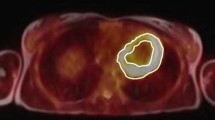Abstract
Purpose:
Integrated PET/MRI imaging system has been widely used in clinical and research applications since it can simultaneously provide functional and structural information. Accurate attenuation correction (AC) is an important challenge that PET/MRI must overcome to obtain correct quantification results and clinical diagnosis. This study aimed to determine the relationship between the radioactivity concentrations produced by computed tomography AC (CTAC) and that produced by magmetic resonance AC (MRAC) and investigate the possibility of comparing the acquired results from different integrated imaging systems.
Methods:
This study used the American College of Radiology (ACR), the International Electrotechnical Commission (IEC), and striatal phantom to simulate the attenuation of organs (lung, abdomen, and head). All phantoms were injected with 18 F-FDG and underwent a PET/CT scan under GE Discovery STE and a PET/MRI scan under GE SIGNA. The built-in AC method was adopted for both scanners. Regions-of-interest (ROIs) were manually drawn, and mean activity concentrations in each ROI were calculated. Relative percent difference and linear correlation were used to compare the obtained results from CTAC and MRAC.
Result:
Strong correlation were found in ACR phantom (CMRAC = 0.77 × CCTAC – 76.26 with R2 = 0.96), IEC phantom (CMRAC = 1.73 × CCTAC – 588.03 with R2 = 0.98), and striatal phantom (CMRAC = 0.75 × CCTAC – 830.61 with R2 = 0.99).
Conclusion:
Quantification results of MRAC were strongly correlated with those of CTAC. Results acquired from different integrated imaging systems can be compared using a linear equation.




(adapted from ACR PET phantom instructions [29])





Similar content being viewed by others
References
Nensa, F., Beiderwellen, K., Heusch, P., & Wetter, A. (2014). Clinical applications of PET/MRI: Current status and future perspectives. Diagnostic and Interventional Radiology, 20(5), 438–447.
Grimm, R., Fürst, S., Souvatzoglou, M., Forman, C., Hutter, J., Dregely, I., et al. (2015). Self-gated MRI motion modeling for respiratory motion compensation in integrated PET/MRI. Medical Image Analysis, 19(1), 110–120.
Acosta, O., Bourgeat, P., Zuluaga, M. A., Fripp, J., Salvado, O., Ourselin, S., Alzheimer’s Disease Neuroimaging Initiative. (2009). Automated voxel-based 3D cortical thickness measurement in a combined Lagrangian–Eulerian PDE approach using partial volume maps. Medical Image Analysis, 13(5), 730–743.
Kinahan, P. E., Townsend, D. W., Beyer, T., & Sashin, D. (1998). Attenuation correction for a combined 3D PET/CT scanner. Medical Physics, 25(10), 2046–2053.
Schulz, V., Torres-Espallardo, I., Renisch, S., Hu, Z., Ojha, N., Börnert, P., et al. (2011). Automatic, three-segment, MR-based attenuation correction for whole-body PET/MR data. European Journal of Nuclear Medicine and Molecular Imaging, 38(1), 138–152.
Zaidi, H., Montandon, M. L., & Slosman, D. O. (2003). Magnetic resonance imaging-guided attenuation and scatter corrections in three‐dimensional brain positron emission tomography. Medical Physics, 30(5), 937–948.
Schlemmer, H. P. W., Pichler, B. J., Schmand, M., Burbar, Z., Michel, C., Ladebeck, R., et al. (2008). Simultaneous MR/PET imaging of the human brain: Feasibility study. Radiology, 248(3), 1028–1035.
Aasheim, L. B., Karlberg, A., Goa, P. E., Håberg, A., Sørhaug, S., Fagerli, U. M., & Eikenes, L. (2015). PET/MR brain imaging: evaluation of clinical UTE-based attenuation correction. European Journal of Nuclear Medicine and Molecular Imaging, 42(9), 1439–1446.
Juttukonda, M. R., Mersereau, B. G., Chen, Y., Su, Y., Rubin, B. G., Benzinger, T. L., et al. (2015). MR-based attenuation correction for PET/MRI neurological studies with continuous-valued attenuation coefficients for bone through a conversion from R2* to CT-Hounsfield units. Neuroimage, 112, 160–168
Cabello, J., Lukas, M., Förster, S., Pyka, T., Nekolla, S. G., & Ziegler, S. I. (2015). MR-based attenuation correction using ultrashort-echo-time pulse sequences in dementia patients. Journal of Nuclear Medicine, 56(3), 423–429
Catana, C., van der Kouwe, A., Benner, T., Michel, C. J., Hamm, M., Fenchel, M., et al. (2010). Toward implementing an MRI-based PET attenuation-correction method for neurologic studies on the MR-PET brain prototype. Journal of Nuclear Medicine, 51(9), 1431–1438.
Keereman, V., Fierens, Y., Broux, T., De Deene, Y., Lonneux, M., & Vandenberghe, S. (2010). MRI-based attenuation correction for PET/MRI using ultrashort echo time sequences. Journal of Nuclear Medicine, 51(5), 812–818.
Hofmann, M., Steinke, F., Scheel, V., Charpiat, G., Farquhar, J., Aschoff, P., et al. (2008). MRI-based attenuation correction for PET/MRI: A novel approach combining pattern recognition and atlas registration. Journal of Nuclear Medicine, 49(11), 1875–1883.
Beyer, T., Weigert, M., Quick, H. H., Pietrzyk, U., Vogt, F., Palm, C., et al. (2008). MR-based attenuation correction for torso-PET/MR imaging: pitfalls in mapping MR to CT data. European Journal of Nuclear Medicine and Molecular Imaging, 35(6), 1142–1146.
Sekine, T., Buck, A., Delso, G., Ter Voert, E. E., Huellner, M., Veit-Haibach, P., & Warnock, G. (2016). Evaluation of atlas-based attenuation correction for integrated PET/MR in human brain: application of a head atlas and comparison to true CT-based attenuation correction. Journal of Nuclear Medicine, 57(2), 215–220
Kops, E. R., Hautzel, H., Herzog, H., Antoch, G., & Shah, N. J. (2015). Comparison of template-based versus CT-based attenuation correction for hybrid MR/PET scanners. IEEE Transactions on Nuclear Science, 62(5), 2115–2121
Koesters, T., Friedman, K. P., Fenchel, M., Zhan, Y., Hermosillo, G., Babb, J., et al. (2016). Dixon sequence with superimposed model-based bone compartment provides highly accurate PET/MR attenuation correction of the brain. Journal of Nuclear Medicine, 57(6), 918–924
Salomon, A., Goedicke, A., Schweizer, B., Aach, T., & Schulz, V. (2010). Simultaneous reconstruction of activity and attenuation for PET/MR. IEEE Transactions on Medical Imaging, 30(3), 804–813.
Nuyts, J., Bal, G., Kehren, F., Fenchel, M., Michel, C., & Watson, C. (2012). Completion of a truncated attenuation image from the attenuated PET emission data. IEEE Transactions on Medical Imaging, 32(2), 237–246.
Defrise, M., Rezaei, A., & Nuyts, J. (2012). Time-of-flight PET data determine the attenuation sinogram up to a constant. Physics in Medicine & Biology, 57(4), 885.
Boellaard, R., Hofman, M. B. M., Hoekstra, O. S., & Lammertsma, A. A. (2014). Accurate PET/MR quantification using time of flight MLAA image reconstruction. Molecular Imaging and Biology, 16(4), 469–477.
Rezaei, A., Defrise, M., & Nuyts, J. (2014). ML-reconstruction for TOF-PET with simultaneous estimation of the attenuation factors. IEEE Transactions on Medical Imaging, 33(7), 1563–1572.
Weiger, M., Hennel, F., & Pruessmann, K. P. (2010). Sweep MRI with algebraic reconstruction. Magnetic Resonance in Medicine, 64(6), 1685–1695.
Hofmann, M., Bezrukov, I., Mantlik, F., Aschoff, P., Steinke, F., Beyer, T., et al. (2011). MRI-based attenuation correction for whole-body PET/MRI: quantitative evaluation of segmentation-and atlas-based methods. Journal of Nuclear Medicine, 52(9), 1392–1399.
Leynes, A. P., Yang, J., Wiesinger, F., Kaushik, S. S., Shanbhag, D. D., Seo, Y., et al. (2018). Direct pseudoCT generation for pelvis PET/MRI attenuation correction using deep convolutional neural networks with multi-parametric MRI: zero echo-time and Dixon deep pseudoCT (ZeDD-CT). Journal of Nuclear Medicine, 59(5), 852–858.
MacFarlane, C. R. (2006). ACR accreditation of nuclear medicine and PET imaging departments. Journal of Nuclear Medicine Technology, 34(1), 18–24.
Ziegler, S., Jakoby, B. W., Braun, H., Paulus, D. H., & Quick, H. H. (2015). NEMA image quality phantom measurements and attenuation correction in integrated PET/MR hybrid imaging. EJNMMI Physics, 2(1), 1–14.
Wu, C. H., Yang, B. H., Chou, Y. H., Wang, S. J., & Chen, J. C. (2018). Effects of 99mTc-TRODAT-1 drug template on image quantitative analysis. PLoS ONE, 13(3).
American College of Radiology. (2010). PET phantom instructions for evaluation of PET image quality
National Electrical Manufacturers Association. (2007). Performance measurements of positron emission tomographs. NEMA Standards Publication NU, 2-2007, 1–33
Wollenweber, S. D., Ambwani, S., Delso, G., Lonn, A. H. R., Mullick, R., Wiesinger, F., et al. (2013). Evaluation of an atlas-based PET head attenuation correction using PET/CT & MR patient data. IEEE Transactions on Nuclear Science, 60(5), 3383–3390.
Wambersie, A. (1989). ICRU Report 44: Tissue Substitutes in Radiation Dosimetry and Measurement. Bethesda (US): International Commission on Radiation Units and Measurements
Leynes, A. P., Yang, J., Shanbhag, D. D., Kaushik, S. S., Seo, Y., Hope, T. A., et al. (2017). Hybrid ZTE/Dixon MR-based attenuation correction for quantitative uptake estimation of pelvic lesions in PET/MRI. Medical Physics, 44(3), 902–913.
Funding
The authors declare that no funds, grants, or other support were received during the preparation of this manuscript.
Author information
Authors and Affiliations
Contributions
Writing - review and editing: C-HW, B-HY; Supervision: C-YT, Y-HL; Conceptualization: C-HW, L-CS, B-HY; Methodology: C-HW, L-CS; Formal analysis and investigation: C-HW; Writing - original draft preparation: C-HW.
Corresponding author
Ethics declarations
Conflict of interest
The authors have no relevant financial or non-financial interests to disclose.
Additional information
Publisher’s note
Springer Nature remains neutral with regard to jurisdictional claims in published maps and institutional affiliations.
Rights and permissions
About this article
Cite this article
Wu, CH., Tu, CY., Shen, LC. et al. Impact of CT-Based and MRI-Based Attenuation Correction Methods on 18 F-FDG PET Quantification Using PET Phantoms. J. Med. Biol. Eng. 42, 374–381 (2022). https://doi.org/10.1007/s40846-022-00716-5
Received:
Accepted:
Published:
Issue Date:
DOI: https://doi.org/10.1007/s40846-022-00716-5




